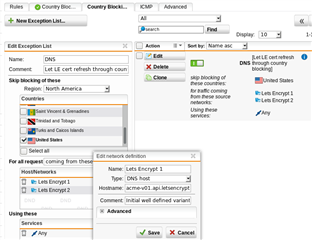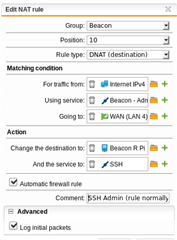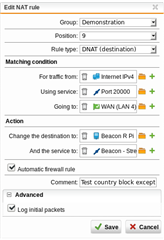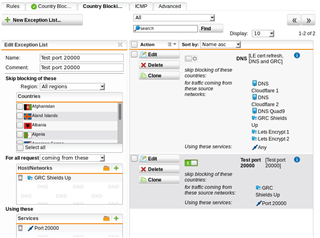I can't figure out how to get a country blocking exception rule to work with a DNAT that redirects internet traffic (from a particular IP) to an internal host while also redirecting from port 123 to port 22.
I want to allow SSH access for a single public IP address which is blocked by Country Blocking. I want the end user to use port 123 instead of port 22. For this example, let's say their public IP is 1.1.1.1. My static, public IP that I have assigned to an external interface is 2.2.2.2. The IP address of my internal host is 192.168.0.2.
So the external end user will use 2.2.2.2:123 to gain SSH access to my internal host.
My Country Blocking Exception:
Skip blocking of these regions: Empty
For all request->coming from these: 1.1.1.1
Using these services: 123
My DNAT:
For traffic from: 1.1.1.1
Using service: 123
Going to: External Interface 2.2.2.2
Change the destination to: 192.168.0.2
And the service to: 22
My Firewall Rule:
Sources: 1.1.1.1
Services: 22
Destinations: 192.168.0.2
Action: Allow
Below is an entry in the firewall log:
2019:04:17-18:13:21 gateway ulogd[3642]: id="2021" severity="info" sys="SecureNet" sub="packetfilter" name="Packet dropped (GEOIP)" action="drop" fwrule="60019" initf="eth1" outitf="eth0" srcmac="xx:xx:xx:xx:xx:xx" dstmac="xx:xx:xx:xx:xx:xx" srcip="1.1.1.1" dstip="192.168.0.2" proto="6" length="60" tos="0x00" prec="0x20" ttl="47" srcport="45986" dstport="22" tcpflags="SYN"
As you can see from the log entry, the local IP on port 22 is being blocked by Country Blocking.
So what is the proper way to set this up? If I add port 22 to my country blocking exception, it seems to work but that opens port 22 to the end user and defeats the purpose of the DNAT, doesn't it?
This thread was automatically locked due to age.






